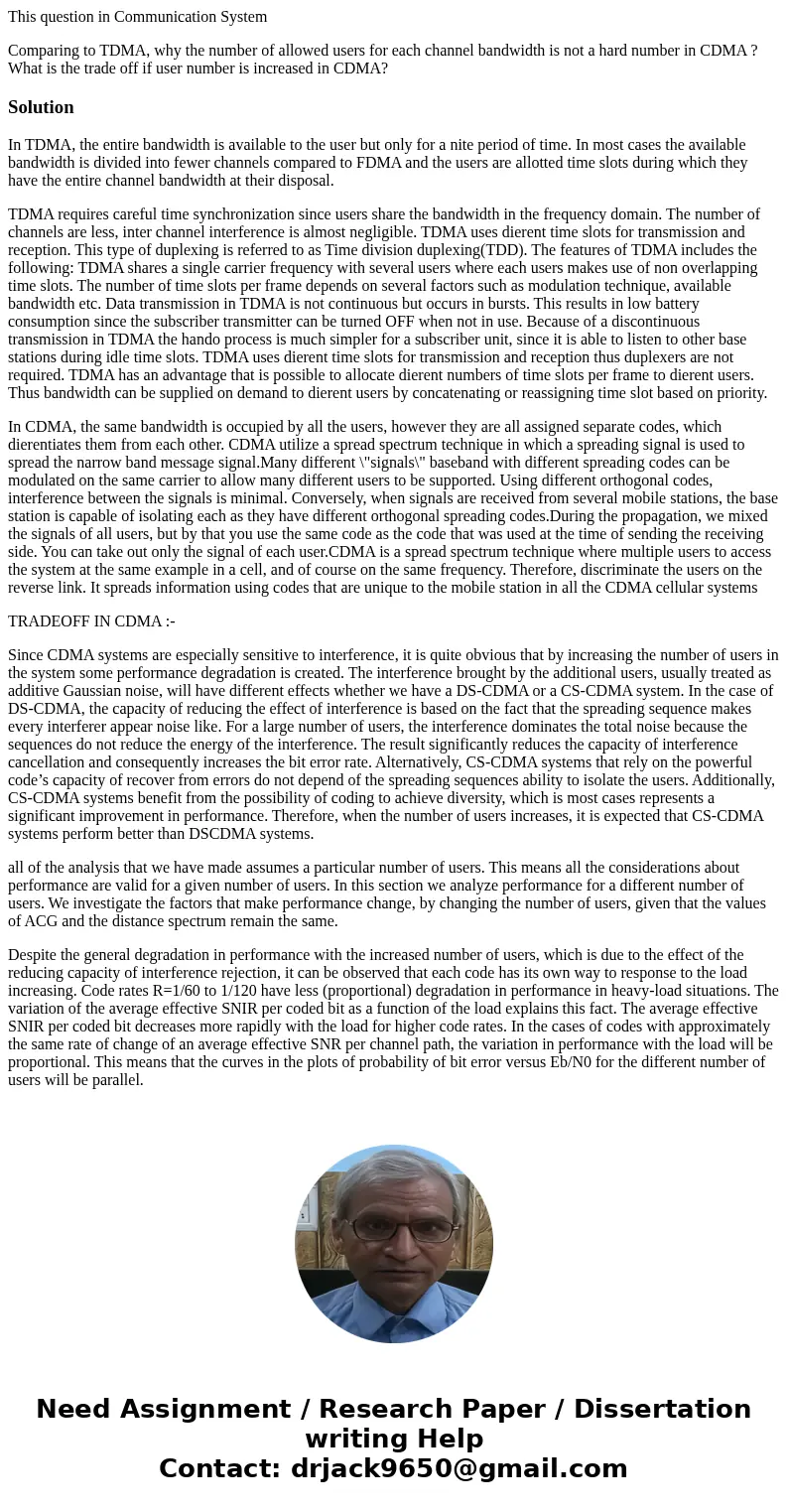This question in Communication System Comparing to TDMA why
This question in Communication System
Comparing to TDMA, why the number of allowed users for each channel bandwidth is not a hard number in CDMA ? What is the trade off if user number is increased in CDMA?
Solution
In TDMA, the entire bandwidth is available to the user but only for a nite period of time. In most cases the available bandwidth is divided into fewer channels compared to FDMA and the users are allotted time slots during which they have the entire channel bandwidth at their disposal.
TDMA requires careful time synchronization since users share the bandwidth in the frequency domain. The number of channels are less, inter channel interference is almost negligible. TDMA uses dierent time slots for transmission and reception. This type of duplexing is referred to as Time division duplexing(TDD). The features of TDMA includes the following: TDMA shares a single carrier frequency with several users where each users makes use of non overlapping time slots. The number of time slots per frame depends on several factors such as modulation technique, available bandwidth etc. Data transmission in TDMA is not continuous but occurs in bursts. This results in low battery consumption since the subscriber transmitter can be turned OFF when not in use. Because of a discontinuous transmission in TDMA the hando process is much simpler for a subscriber unit, since it is able to listen to other base stations during idle time slots. TDMA uses dierent time slots for transmission and reception thus duplexers are not required. TDMA has an advantage that is possible to allocate dierent numbers of time slots per frame to dierent users. Thus bandwidth can be supplied on demand to dierent users by concatenating or reassigning time slot based on priority.
In CDMA, the same bandwidth is occupied by all the users, however they are all assigned separate codes, which dierentiates them from each other. CDMA utilize a spread spectrum technique in which a spreading signal is used to spread the narrow band message signal.Many different \"signals\" baseband with different spreading codes can be modulated on the same carrier to allow many different users to be supported. Using different orthogonal codes, interference between the signals is minimal. Conversely, when signals are received from several mobile stations, the base station is capable of isolating each as they have different orthogonal spreading codes.During the propagation, we mixed the signals of all users, but by that you use the same code as the code that was used at the time of sending the receiving side. You can take out only the signal of each user.CDMA is a spread spectrum technique where multiple users to access the system at the same example in a cell, and of course on the same frequency. Therefore, discriminate the users on the reverse link. It spreads information using codes that are unique to the mobile station in all the CDMA cellular systems
TRADEOFF IN CDMA :-
Since CDMA systems are especially sensitive to interference, it is quite obvious that by increasing the number of users in the system some performance degradation is created. The interference brought by the additional users, usually treated as additive Gaussian noise, will have different effects whether we have a DS-CDMA or a CS-CDMA system. In the case of DS-CDMA, the capacity of reducing the effect of interference is based on the fact that the spreading sequence makes every interferer appear noise like. For a large number of users, the interference dominates the total noise because the sequences do not reduce the energy of the interference. The result significantly reduces the capacity of interference cancellation and consequently increases the bit error rate. Alternatively, CS-CDMA systems that rely on the powerful code’s capacity of recover from errors do not depend of the spreading sequences ability to isolate the users. Additionally, CS-CDMA systems benefit from the possibility of coding to achieve diversity, which is most cases represents a significant improvement in performance. Therefore, when the number of users increases, it is expected that CS-CDMA systems perform better than DSCDMA systems.
all of the analysis that we have made assumes a particular number of users. This means all the considerations about performance are valid for a given number of users. In this section we analyze performance for a different number of users. We investigate the factors that make performance change, by changing the number of users, given that the values of ACG and the distance spectrum remain the same.
Despite the general degradation in performance with the increased number of users, which is due to the effect of the reducing capacity of interference rejection, it can be observed that each code has its own way to response to the load increasing. Code rates R=1/60 to 1/120 have less (proportional) degradation in performance in heavy-load situations. The variation of the average effective SNIR per coded bit as a function of the load explains this fact. The average effective SNIR per coded bit decreases more rapidly with the load for higher code rates. In the cases of codes with approximately the same rate of change of an average effective SNR per channel path, the variation in performance with the load will be proportional. This means that the curves in the plots of probability of bit error versus Eb/N0 for the different number of users will be parallel.

 Homework Sourse
Homework Sourse